I’m back at the new house today. It’s a good day to be here. The wind, which wuthers 98% of the time, is having a break and in the stillness I can hear the birds living their best lives out on the marsh and the trickling of my tiny pond. The weeny steam train that runs at the bottom of my garden toots past leaving a pleasing smell of soot behind. I thought I would love my sea views best but it is the eerie wonder of the marsh that captivates me.
I am writing this between taking deliveries of plaster board and filling the oil tank. There may be another delivery hoving into view, it’s hard to say. We cancelled it but they seem to be intent on delivering anyway.
It’s nice to be still for a moment, even if it is in the beat between all the things that demand movement.
I did manage a day off this week. On Monday everyone else had to be in different locations. I was also supposed to be somewhere else, but we realised that nobody would be at the boat to pander to the needs of Derek, our increasingly demanding cat. My being somewhere else was the easiest to rearrange so I bowed to the pressure to wait on Derek. I took advantage in the day, when she mostly likes to sleep in extravagant and inconvenient ways, to go to Tate Modern and see the Aids Quilt UK.
It was only on display from 12th to 16th July and I had resigned myself to missing it because making my house liveable had to be a priority. When the opportunity to see it on its last day in the Turbine Hall came up, I hot footed it across London, and I am so glad I did.
It was one of the most profound, beautiful and moving things I have ever seen. A third of the way up the first strip of quilt I started weeping and didn’t stop. I am extremely British. Crying in public is anathema to me, but I couldn’t stop the tears from falling. I wasn’t the only one.
I’ve been trying to arrange my thoughts about it ever since. Intellectually I am fascinated by the use of textiles in fine art spaces. Crafting has historically been seen as the poor relation to ‘real’ art, and the shift in acceptance through a re-evaluation of things like the Gees Bend quilters and the work of people like Tracey Emin and Grayson Perry is refreshing and long overdue.
I was also drawn to think about the use of textiles and banners in terms of historical advocacy and political protest. The Suffragettes, working men’s clubs and mining communities in the UK all used textiles as a form of protest and as a way of making visible that which other parts of society wanted to ignore.
The AIDS Quilt UK took its inspiration from the AIDS Quilt in America, where quilting has a long and important history and tradition. It bridges and merges two communities devastated by the loss of its members, connecting and strengthening them in a shared experience and allowing them to find a new, enduring language in an old tradition. The way quilts are made, piecing scraps together is for me, a metaphor of how these communities were able to rebuild themselves. It seems fitting that a quilt tells that story.
Traditionally, quilts were stitched by the women in a community. They would often come together to work, forging friendships, strengthening ties, building a network that underpinned the day to day comings and goings of their town or village. The fabric would often be pieced together from textiles in the home that were no longer fit for purpose but which could still be used for quilting. The quilts contained lives, memories, markers of events large and small. In using what would otherwise be thrown away, they were given a new life in a different shape. The quilts provided warmth and comfort. People would be wrapped in the memories of their lives. The work of the quilters was often unnoticed, because it was considered domestic. The work that holds a community together is so often unsung. It is so important then that the AIDS Quilt has the opportunity to be seen, as it was over the last few days.
The irony is not lost on me that the AIDS Quilt was forged out of loss, of people, of health, of community of the future. This quilt wasn’t made to comfort the men who died. It stands as a marker for the fact that this comfort was so often denied to them.
This quilt is for those who are left behind. This quilt was created by outsiders whose hard fought for communities were decimated by not only AIDS itself but the callous indifference of the politicians, health providers and law givers who had to be forced to act in the face of an immeasurable loss they not only didn’t care about, but preferred to see as useful.
This quilt represents a community who had to find new ways to knit themselves back together and build a different kind of comfort, a new kind of resilience and the energy to fight in the face of enormous physical and emotional odds. It speaks of resilience, rebellion and anger.
But most of all it speaks about love.
Seeing all the different pieces, I was struck, not just by how many creative people were lost to their profession and the enrichment of our culture, not just by how many names I recognised, but by how many, for want of a better word ‘ordinary’ people are remembered. How poor our society is now for the absence of those people, their skills, their quirks, their humour, their humanity, all gone. How many of those people, given the chance would have gone on to make the lives we live now better, for all of us, whether through what they would have gone on to do, or who they would have gone on to become? Their absence makes us all poorer.
I thought about the loss of all those children, partners, siblings, lovers, friends and relations. I thought about all those families, biological and logical, who were and are punched through with loss. All the birthdays, all the dinners that will always have an empty seat. All the anniversaries which are now shaded with pain. All the love with nowhere to go but in the direction of grief.
What I thought about most was how strikingly and beautifully ordinary the things these people were being remembered for. The man who loved cricket, the man who loved his allotment and finding the poles for his runner beans to grow up. The men who wrote, painted and sang. The men who rode motorbikes and had cats. The men who liked rambling and trees. The men with record collections and tropical fish. The twitchers, the dancers, the people who lit up every room. All gone.
And the friendships, so many friendships, beautiful, complex, gorgeous friendships that held these men when everyone else walked away. Including in some cases, their own families.
I thought about all the hateful noise around gender politics and the transphobes who are obsessed by genitalia, sex and violence, who boil whole communities down to which bit of anatomy goes where. I thought about the fact that their rhetoric has no place here. There are no quilts depicting fucking and fisting and going into the ‘wrong’ bathroom. Not that I don’t think that these shouldn’t be depicted on a quilt if someone felt the need. I thought about how this reductive, ugly, sad view of the lives of others misses the point entirely and how this quilt IS the point entirely.
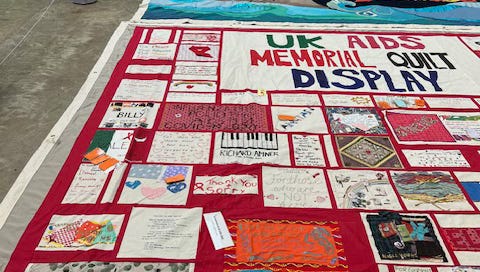




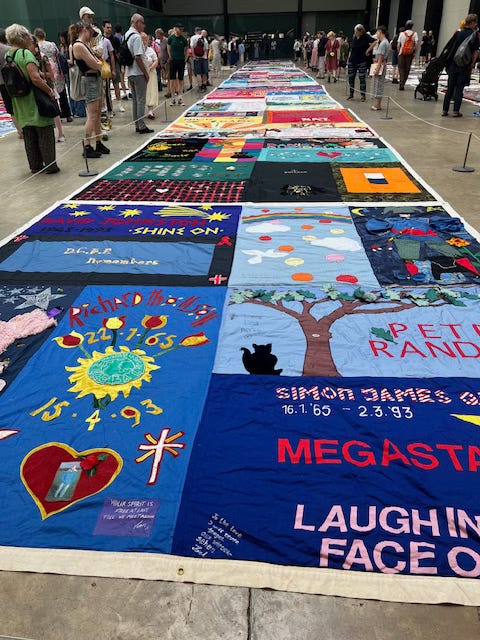
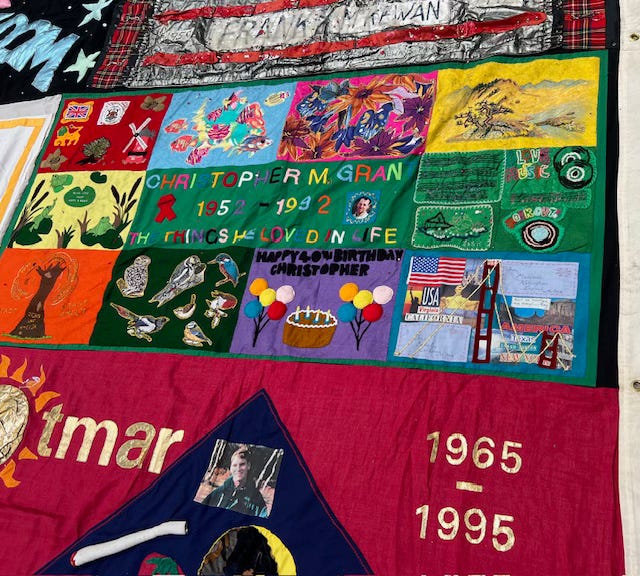
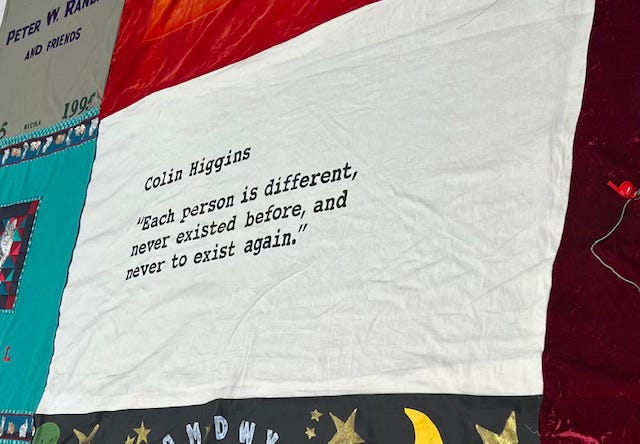


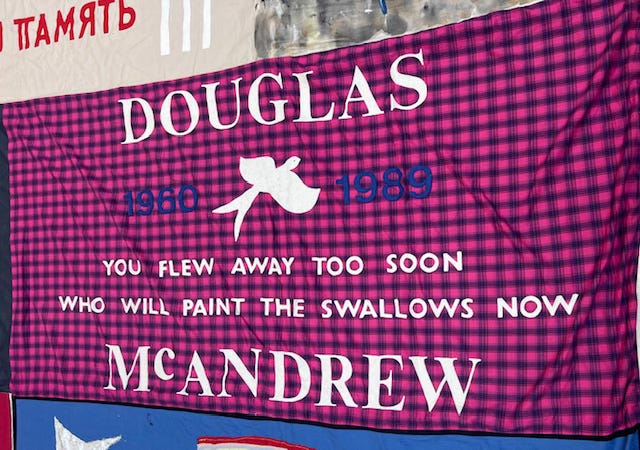
Beautifully and powerfully put Katy. We lost some lovely people. Our job is to remember them with love. Thank you for writing this.
Thank you for these reflections, Katy.
I remember the fear of the AIDS epidemic/crisis in the 1980s and as a result, I felt fearful of gay men (which was irrational because the chance of me getting AIDS was minuscule). I then learned a coworker was gay and we were talking about our hopes and dreams for the future. It turned out that we wanted the same things: love, happiness, success. My fear dissolved in an instant. We are human, all of us. And these people have been demonized because of who they loved. Sadly, they still are and the acceptance that we had made in the US is suffering a major setback with the current regime. It’s infuriating and heartbreaking.